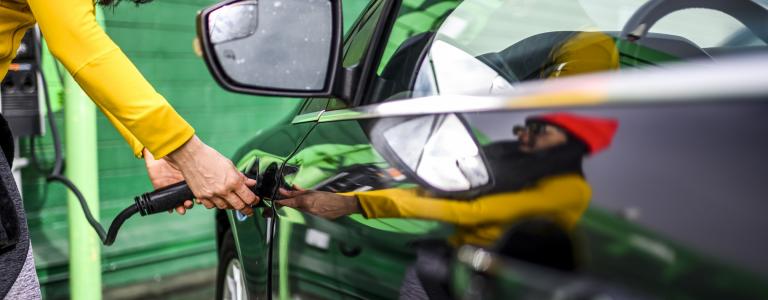Can Trade in Electric Vehicle Raw Materials Create Development Opportunities?
As demand grows for electric vehicles, there are valuable lessons to learn from Chile and the Democratic Republic of the Congo.
The electric vehicle (EV) industry has grown significantly in the last few years. Despite a decline in 2020 due to the COVID-19 pandemic, EV sales overall were more resilient than those of internal combustion engine vehicles. Growth forecasts also remain encouraging, with the share of EV sales expected to increase from 2% in 2018 to 35% in 2030.
This growth depends on strong supply chains, which rely on a secure and sustainable supply of raw materials, specifically minerals and metals. The most critical EV component is the battery, which encompasses between one third and one quarter of the vehicle’s total cost of production. In 2018, raw materials accounted for about 10% of EV production costs.
Two important materials in lithium-ion batteries today are lithium and cobalt, which are both found in large amounts in developing countries such as Chile and the Democratic Republic of the Congo (DRC). The growing interest and projected increases in manufacturing EVs, along with the subsequent rising demand for specific minerals needed for this, present key opportunities for developing countries to step up as suppliers.
The growing interest and projected increases in manufacturing EVs, along with the subsequent rising demand for specific minerals needed for this, present key opportunities for developing countries to step up as suppliers.
Their ability to take advantage of this opportunity, however, depends on each country’s economic and political readiness to promote investment in sustainable production and to put in place trade and industrial policies that will shape the growth of their mining and manufacturing sectors while creating employment and value addition. Evolving battery technology also brings risks to raw material producers, as different battery chemistries require different raw materials. Investments in production and processing assets could become stranded if technological change leads to reduced demand for certain raw materials.
Lessons from Chile and the DRC
Chile, for example, has significant comparative advantages for lithium extraction and refining. The country holds the largest percentage of the international reserves, and its extraction processes—which use natural evaporation driven by the sun’s energy—use less energy than extraction processes elsewhere.
However, the Chilean lithium industry has been slow to scale up due to a combination of regulatory uncertainty and technical challenges. To take advantage of rising lithium demand, the Chilean government must overcome these barriers while taking into account the need for environmental protection, sustainable water management, and local communities’ priorities.
Another example pertains to cobalt production in the DRC. The DRC was responsible for 71% of global cobalt production in 2019 and just over 50% of worldwide reserves. Large-scale or industrial mining is responsible for over two thirds of cobalt production in the DRC, with the other third supplied by artisanal mines. While some of this artisanal mining is formal and registered, most is not and is often associated with unethical labour practices.
Supply chain concerns are driving innovation away from cobalt, with batteries continuously reducing, or even eliminating, the use of cobalt. The most noteworthy example of the result of such pressure imposed on downstream manufacturers is the ongoing class-action lawsuit brought against Apple, Google, Microsoft, Dell, and Tesla by a human rights group on behalf of victims injured or killed in artisanal mining in December 2019. The lawsuit identified both producers and intermediaries, including some of the largest cobalt producers.
Supply chain concerns are driving innovation away from cobalt, with batteries continuously reducing, or even eliminating, the use of cobalt.
In recent years, two other scandals underlined some of the challenges undermining the development of a trustworthy, ethical, and efficient cobalt industry. The first was related to corrupt mining deals, which were estimated to have deprived the Congolese state of over USD 1.3 billion in revenues. A second involved a Swiss criminal investigation into one of the largest international cobalt mining companies (Glencore) over its alleged corrupt practices in the DRC.
The political and governance challenges associated with mining have led some regulators around the world to tighten their oversight of the activities of their multinational companies, intermediaries, and even state-owned mining companies.
Battery producers are already working to develop batteries that rely less on primary materials, especially cobalt, as a result. Lithium-ion batteries already appear set to play a dominant role in the decade ahead, while technological revolutions are underway with regard to eliminating cobalt. As a result, it is imperative for lithium and cobalt producers and governments in mineral-rich countries to value this risk and plan their long-run mining policies accordingly.
Striking a delicate balance
Developing country governments have a range of trade, investment, and industrial policy tools available to maximize the development outcomes they can achieve from the EV boom. These include providing an enabling environment through an open and predictable trade regime and effective border clearance mechanisms. They also involve actions to improve connectivity, including transport, logistics services, and information and communications technology (ICT).
Developing country governments have a range of trade, investment, and industrial policy tools available to maximize the development outcomes they can achieve from the EV boom.
Governments that seek enhanced domestic value addition have also been using export restrictions and local content requirements, though it is worth noting that these measures could face legal challenges at the World Trade Organization, along with prompting concerns about their impact on the openness and predictability of the multilateral trading system.
In practice, there is a delicate balance to be struck between allowing sufficient flexibility in business operations to attract foreign investment and creating domestic employment, opportunities for value addition, or industrial development. Where demand for key raw materials looks stable in the medium term, policies that promote value-adding activities would appear to be a good long-term option, as long as the “created” industries are economically viable. Where demand for a key material is volatile, and in particular where it is likely to fall, trade measures to encourage domestic refining of those minerals run the risk of stranding assets, and revenue might be better applied to supporting the diversification of economic activity in the extractives sector.
Funded by
You might also be interested in
Net-Zero Should Not Be a Net Loss for Low-Income Economies
As countries make the transition towards net-zero economies, what do these policies mean for international trade?
Carbon border adjustments are back in the spotlight
Canadian Finance Minister Chrystia Freeland’s recently released mandate letter will keep her busy for the foreseeable future.
How Can Trade Maximize Gains From Clean Energy Investment in Developing Countries?
As governments increasingly turn to trade policy to support the renewable energy transition, they also need to encourage the production of key components at home.
Une course aux subventions aux armements s’engage entre l’Europe et l’Amérique (in French)
Lorsque le président américain Joe Biden a promulgué la loi sur la réduction de l’inflation, il a promulgué le plus grand investissement climatique de l’histoire américaine – un moment historique pour une nation qui pompe plus de carbone dans l’atmosphère que n’importe quel pays à l’exception de la Chine.

